To teach kids to write thank-you notes, start by explaining why showing gratitude matters and create a fun routine. Help them personalize messages by mentioning specific gifts and how they’ll use them, using their own words for sincerity. Choose colorful or elegant stationery that suits their personality. Practice together by writing sample notes, praising their efforts, and emphasizing neatness. If you keep guiding them through this process, you’ll find it becomes easier and more meaningful over time.
Key Takeaways
- Practice writing sample thank-you notes together to build confidence and demonstrate proper structure.
- Encourage kids to mention specific details about the gift and their feelings to make messages genuine.
- Use colorful or fun stationery to make writing thank-you notes an engaging activity.
- Teach kids to include a greeting, express gratitude, mention the gift, and close politely.
- Reinforce the importance of personalized messages and consistency to develop a meaningful gratitude routine.

Teaching kids to write thank-you notes is an important skill that helps them express gratitude and develop good manners. When guiding your child through this process, start by emphasizing the importance of crafting heartfelt messages. Encourage them to think about the giver and what they appreciate about the gift. Instead of generic phrases, help them personalize each note with specific details, like mentioning how they plan to use the gift or why it made them happy. This sincere touch shows genuine appreciation and makes the note meaningful.
Selecting appropriate stationery is also a key part of teaching kids to write thank-you notes. Show them a variety of options, from colorful cards to simple, elegant paper. Let them choose stationery that reflects their personality or the occasion. Bright, playful designs work well for children, making the task more fun. Explain that neat handwriting and thoughtful presentation matter just as much as the message itself. Using good-quality paper or cards can make the thank-you note feel special and important, reinforcing the idea that gratitude deserves thoughtful effort.
Choose colorful or elegant stationery to make thank-you notes fun and meaningful for kids.
Once they’ve chosen their stationery, teach them how to structure their message. A typical note should include a greeting, a clear expression of thanks, a specific mention of the gift, and a closing. For example, “Dear Aunt Lisa, thank you so much for the beautiful art supplies. I can’t wait to use the new paints and brushes for my next project.” Encourage your child to write in their own words, making the message heartfelt rather than overly formal. Remind them to check for neatness and spelling before sending it off.
You can also make the process more engaging by practicing together. Write a few sample notes, helping them craft sincere messages. Show them how to start with a warm greeting, then move into expressing gratitude and mentioning the gift specifically. Praise their efforts to boost confidence and make the task enjoyable. Over time, writing thank-you notes will become a natural part of their routine, teaching them the value of appreciation and good manners. Additionally, explaining the importance of personalized messages can help deepen their understanding of meaningful communication.
Frequently Asked Questions
How Can I Motivate My Child to Write Thank-You Notes?
You can motivate your child to write thank-you notes by involving them in the process and using reward systems. Show parental involvement by helping them brainstorm, write, or decorate the notes, making it a fun activity. Offer small rewards or praise once they complete each note, reinforcing positive behavior. By showing support and celebrating their effort, you’ll encourage your child to develop good thank-you habits naturally.
What Are Age-Appropriate Ways to Teach Gratitude Through Thank-You Notes?
You can teach gratitude through thank-you notes by incorporating age-appropriate gratitude exercises, like asking your child to recall their favorite part of a gift before writing. For example, after receiving a toy, they might say, “I love how soft it is.” This helps them practice gift appreciation and understand gratitude’s value. Use simple language and encourage sincerity to make the notes meaningful and teach gratitude effectively.
How Do I Handle Incomplete or Delayed Thank-You Notes?
When faced with incomplete or delayed thank-you notes, you should address guilt gently and handle excuses patiently. Talk to your child about the importance of gratitude and remind them of their commitments. Encourage them to finish the notes without feeling guilty, emphasizing that everyone makes mistakes. Offer to help if needed, and praise their effort to foster responsibility and understanding, making the process a positive learning experience.
Should Thank-You Notes Be Handwritten or Can They Be Digital?
Think of thank-you notes as bridges connecting hearts; whether handwritten or digital, they carry sincere gratitude. Handwritten notes embody authenticity and personal touch, showing you took extra time. Digital etiquette offers convenience, especially when speed matters. You can encourage your kids to choose based on the situation, but remind them that the heartfelt gesture matters most. Either way, genuine gratitude shines through, strengthening relationships like a sturdy bridge built with love.
How Can I Encourage Sincerity in My Child’s Thank-You Messages?
To encourage sincerity in your child’s thank-you messages, suggest they include personalized examples of how the gift made them feel or what they enjoyed about it. You can also promote gratitude journaling, where they regularly write about things they’re thankful for, which helps foster genuine appreciation. When they write thank-you notes, remind them to reflect on their feelings and be specific, making their gratitude heartfelt and authentic.
Conclusion
Teaching your kids to write thank-you notes not only shows appreciation but also builds gratitude skills they’ll carry for life. Did you know that children who practice gratitude early on tend to be happier and more empathetic? Helping them craft these notes turns a simple thank you into a meaningful lesson in kindness. So, start now—your effort can make a lasting impact on their character and relationships.









